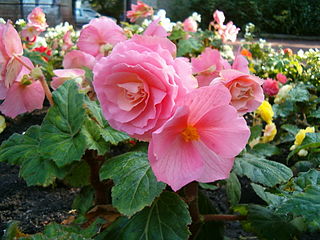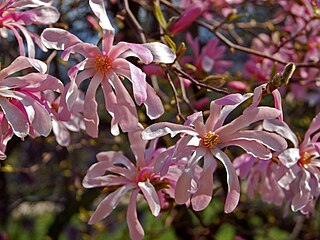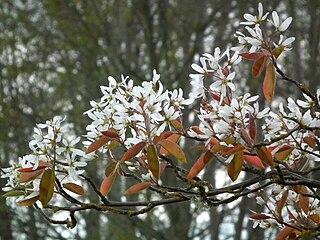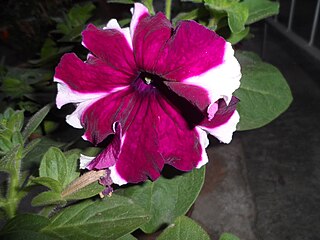
Epacris impressa, also known as common heath, is a plant of the heath family, Ericaceae, that is native to southeast Australia. French botanist Jacques Labillardière collected the species in 1793 and described it in 1805. Four forms have been identified, but no subspecies are recognised. Growing in heathland, shrubland or open forest, it is generally a small shrub around 0.5 to 1 m tall, with small stiff leaves. The red, pink or white tube-like flowers appear from late autumn to early spring. Honeyeater birds, particularly the eastern spinebill, feed upon the nectar of the flowers. It regenerates after bushfire by seed or by resprouting.

Magnolia virginiana, most commonly known as sweetbay magnolia, or merely sweetbay, is a member of the magnolia family, Magnoliaceae. It was the first magnolia to be scientifically described under modern rules of botanical nomenclature, and is the type species of the genus Magnolia; as Magnolia is also the type genus of all flowering plants (magnoliophytes), this species in a sense typifies all flowering plants.

Magnolia grandiflora, commonly known as the southern magnolia or bull bay, is a tree of the family Magnoliaceae native to the southeastern United States, from Virginia to central Florida, and west to East Texas. Reaching 27.5 m (90 ft) in height, it is a large, striking evergreen tree, with large dark green leaves up to 20 cm long and 12 cm wide, and large, white, fragrant flowers up to 30 cm (12 in) in diameter.

Achimenes is a genus of about 25 species of tropical and subtropical rhizomatous perennial herbs in the flowering plant family Gesneriaceae. They have a multitude of common names such as magic flowers, widow's tears, Cupid's bower, or hot water plant.

Schisandra chinensis, whose fruit is called magnolia berry or five-flavor-fruit, is a vine plant native to forests of Northern China and the Russian Far East and Korea. Wild varieties of Schisandra chinensis are also found in Japan. It is hardy in USDA Zone 4. The fruits are red berries in dense clusters around 10 centimetres (3.9 in) long.

[[File:|thumb|right|]]

Thunbergia mysorensis, also called Mysore trumpetvine or Indian clock vine, is a species of flowering plant in the family Acanthaceae. A woody-stemmed evergreen, this vine is native to southern tropical India. The specific epithet mysorensis is derived from the city of Mysore. Other vernacular names include brick & butter vine, lady's slipper vine, and dolls' shoes due to the flower shape and large size.

Uvularia grandiflora, the large-flowered bellwort or merrybells, is a species of flowering plant in the family Colchicaceae, native to eastern and central North America.

Digitalis grandiflora, the yellow foxglove, big-flowered foxglove, or large yellow foxglove, is a species of flowering plant in the genus Digitalis, family Plantaginaceae. It is native to southern Europe and Asia. In mountains it grows on warm, bushy slopes or areas left after logging. The Latin specific epithet grandiflora means “large flowered”.

Coreopsis grandiflora is a North American species of perennial plant in the sunflower family Asteraceae. The common name is large-flowered tickseed. It is found in eastern Canada and much of the United States, especially the south-central part of the country. The species is widely cultivated in China and naturalized there.

Libertia grandiflora, the tukauki or mikoikoi, is a flowering plant in the family Iridaceae. The species is endemic to New Zealand. It is a clump-forming herbaceous perennial growing to 90 cm (35 in) tall by 60 cm (24 in) broad, with leathery linear leaves and panicles of white flowers in spring, followed by seed capsules. The Latin grandiflora means large flowered.

Clematis montana is a flowering plant in the buttercup family Ranunculaceae. A vigorous deciduous climber, in late spring it is covered with a mass of small blooms for a period of about four weeks. The flowers are white or pink, four-petalled, with prominent yellow anthers. It is native to mountain areas of Asia from Afghanistan to Taiwan.

Tuberous begonias are a group of Begonia cultivars, sometimes regarded as some of the most spectacular of the genus.

Magnolia × loebneri Kache is a hybrid of two Magnolia species, the Japanese Magnolia kobus and M. stellata. crossed by Garteninspektor Max Löbner of Pillnitz, Germany, shortly before World War I; it first flowered in 1917. The deciduous, elegant and compact multi-stemmed small flowering tree or large shrub, slowly attaining a height of 20 ft (6.1 m) and somewhat wider at maturity, is hardy to USDA Zone 4. Its fragrant late flowers, following its stellata parent by a couple of weeks, escape unexpected late spring frosts, but appear on the bare branches, to great effect. The deep pink buds open in informal strap-like tepals with pale shell pink upper surfaces and darker pink-purple lower ones. Like most magnolias, it thrives best on acid soils.

Amelanchier × grandiflora, the serviceberry, is a small deciduous flowering tree or large shrub, a hybrid of garden origin between A. arborea and A. laevis, in the family Rosaceae. It produces white flowers and small red to purple edible fruits.

Thunbergia grandiflora is an evergreen vine in the family Acanthaceae. It is native to China, India, Nepal, Indochina and Burma and widely naturalised elsewhere. Common names include Bengal clockvine, Bengal trumpet, blue skyflower, blue thunbergia, blue trumpetvine, clockvine, skyflower and skyvine.

Zephyranthes minuta is a plant species very often referred to as Zephyranthes grandiflora, including in Flora of North America. The latter is, however, an illegitimate name because the original author in coining the name Zephyranthes grandiflora listed the older name Amaryllis minuta as a synonym. This makes "minuta" the acceptable epithet under the ICN. It is a recipient of the Royal Horticultural Society's Award of Garden Merit.

Petunia × atkinsiana is a Petunia plant "nothospecies" (hybrid), which encompasses all hybrid species of petunia between P. axillaris and P. integrifolia. Most of the petunias sold for cultivation in home gardens are this type and belong to this nothospecies.

Schisandra rubriflora (红花五味子), the Chinese magnolia vine, is a species of flowering plant in the family Schisandraceae that is native to China, India and Myanmar. Growing to 8 m (26 ft) tall, it is a deciduous twining climber with leathery leaves. Waxy red, cup-shaped pendulous blooms in summer are followed by red berries.



















